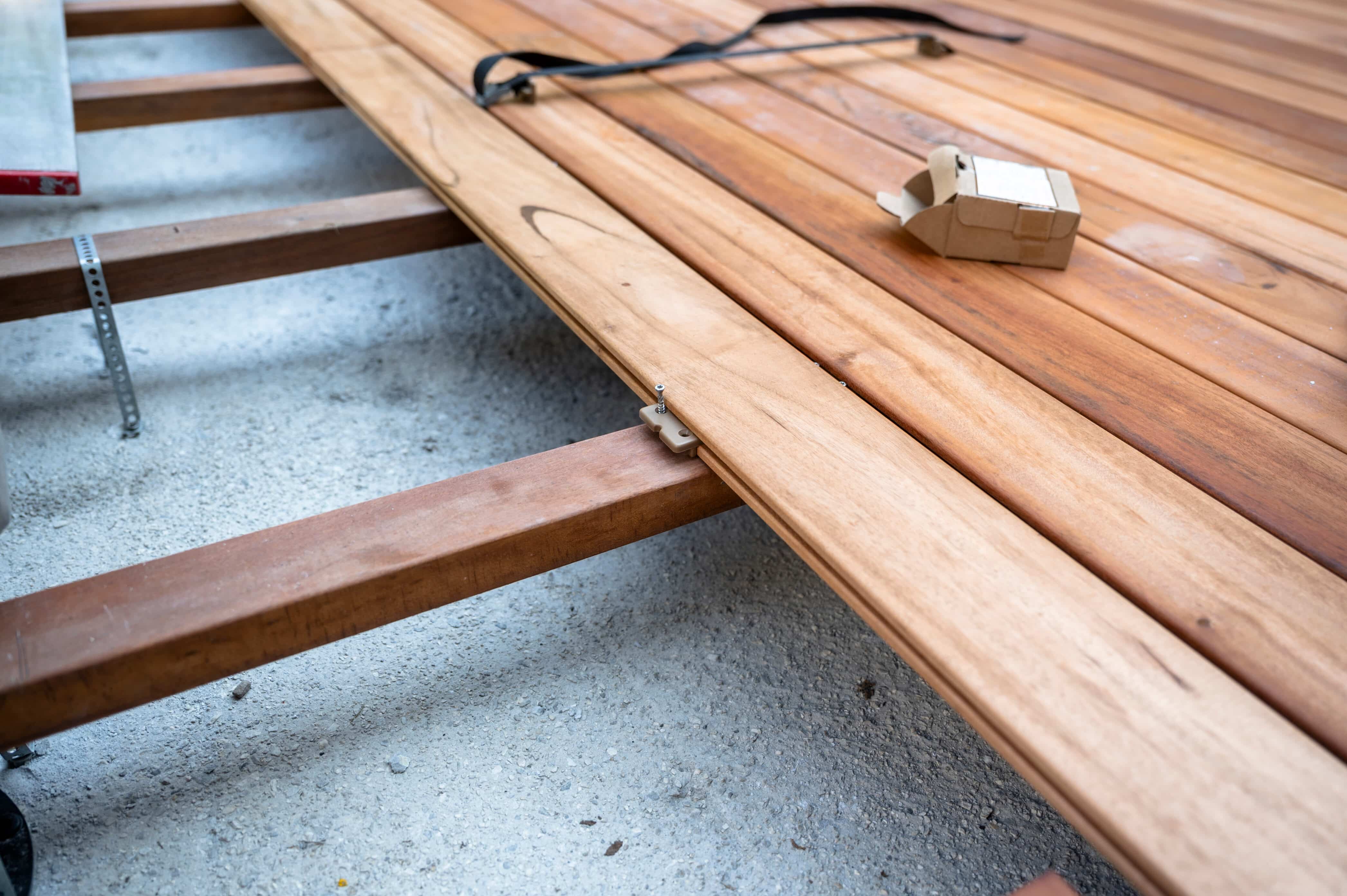
Hidden Fasteners vs. Screws: Which Deck Fastening System Is Best for Your Deck?
One of the most important (and most overlooked) decisions in building a deck is how you fasten down your deck boards with hardware. The right deck fastening system can make the difference between a clean, professional finish and a surface full of splinters, screws, or long-term problems.
But which hardware is better, hidden fasteners or traditional screws? It depends on your material, budget, goals, and how hands-on you plan to be. Whether you’re a seasoned pro or tackling your first DIY deck project, here’s what you should know before you start driving anything into your joists.
Hidden Fasteners Are Sleek, Seamless, And Smart
If you’re dreaming of a smooth, blemish-free deck surface, hidden fasteners deliver. These systems are designed to hold grooved deck boards in place without any visible hardware to enhance the look of your deck or dock. Instead of screws through the top of the board, the fasteners clip into grooves on the sides and attach to the joists underneath.
This setup means:
- No screw heads to snag bare feet or lawn furniture
- A cleaner, more finished look (especially nice with composite decking)
Premium decking material brands like Trex, TimberTech, and Fiberon offer hidden fastener systems unique to their own composite and PVC decking; some brands offer universal fasteners that can be used on several different brands of decking. Many use a clip system, though some work with biscuit-style connectors or specialty tracks, depending on the board style.
If aesthetics are a priority and you’re working with grooved boards, hidden deck fasteners are hard to beat.
Screws Are Simple, Strong, and Straightforward
There’s a reason deck screws are still around. They work! Screwing deck boards directly into the joists is a proven method that’s fast, secure, and affordable.
Screws are especially common in pressure-treated wood decks and solid-edge boards that don’t have grooves. You can color-match them to your boards, and you don’t need extra tools or accessories to get started.
Screws also make repairs easier. Need to swap out a board down the line? Just back out a few screws. Done.
That said, screws come with downsides:
- Exposed heads interrupt the surface
- Poorly installed screws can back out over time
- Misaligned screws can lead to cracked boards or uneven surfaces
Still, for many pros and confident DIYers, screws are a fast, familiar way to secure a deck.
What’s Easier to Install, Screws or Hidden Deck Fasteners?
That depends on your experience and your deck setup.
Screws are plug-and-play. Drill, drive, repeat. It’s easy to get into a rhythm, and if you’re handy with tools, you can move fast. Just remember to pre-drill hardwoods like ipe to avoid splitting, and use quality screws designed for decks, not cheap hardware-store leftovers.
Hidden fasteners require a bit more prep. You’ll need grooved boards, matching fasteners, and possibly some specialty tools. The first and last board can be a little tricky to install cleanly, and precision matters. But once you get the hang of it, it’s not hard. Many systems are designed with easy installation in mind, and some can even speed up your build time once you’re rolling.
If you’re a pro installing high-end composite decks, hidden systems are practically standard. If you’re a DIYer? You can absolutely do it, but it just might take a little longer.
The Dollars and Cents of It All: Not Just About the Price of Fasteners
Let’s talk about cost. Sure, screws are cheaper upfront. You can buy a box of stainless steel deck screws for less than a fancy clip system. Hidden fasteners, on the other hand, are pricier, depending on the brand and board type.
But there’s more to the equation than materials:
- Labor: Hidden fasteners take longer to install, mainly if you haven’t used them before. If you’re hiring a contractor, expect higher labor costs.
- Value: A seamless surface can boost your home’s curb appeal and resale value. Hidden fasteners aren’t just about looks; they’re about longevity and design.
Want to get precise? Our team at Decks & Docks can use a deck coverage calculator to estimate how many fasteners you’ll need for your project.
Match Your Hidden Deck Fastener to Your Board, Because Material Matters
Different decking materials behave differently. Here’s how to line up the right system:
Composite Decking
Most composite boards come with a groove along the side, made for hidden fasteners. Decks & Docks offers a range of composite decking brands with complete fastening systems that are built to match.
Pressure-Treated Wood
This is where screws still dominate. It’s rugged, affordable, and usually installed with face-fastened screws, especially for budget builds.
PVC Decking
Flexible, lightweight, and often grooved, PVC works great with hidden clips.
Tropical Hardwoods
Dense woods like ipe or mahogany may split if screwed incorrectly. If properly installed, hidden fastener systems for ipe, like EB-TY® Premium Hidden Deck Fasteners™, prevent movement that can occur due to moisture.
Choosing the right fastener system for your material means fewer headaches during installation and fewer issues down the road.
What About Repairs and Maintenance?
Screws make repairs easy. Pop a few out, replace the board, drive new ones in.
Hidden fasteners? Not always that simple. To remove a single board, you might need to loosen a few neighbors or work backward from the edge. But some systems—especially modern ones—are designed to make this easier, so be sure to review the details. It’s worth checking if your brand allows partial board replacements without a full teardown. Ask a Decks & Docks team member if you’re unsure when shopping for products.
On the flip side, hidden fasteners keep your boards in better shape long-term, leading to potential savings in repairs. Fewer holes in wood means less chance for rot, cracking, or warping. And with composite deck boards, you don’t need to worry about warping, rotting, or cracking.
Safety: What You Don’t See Can Help
Poorly installed screws can be more than an eyesore; they’re a safety hazard. A raised screw head is just waiting to catch a bare foot, slice a sandal, or snag a chair leg. Rusted screws also weaken over time, especially near saltwater.
Hidden fasteners eliminate all that. With nothing on the surface, there’s nothing to catch, trip, or cut. Especially important if your deck sees a lot of traffic, or if you just want peace of mind.
Which Should You Choose?
There’s no one-size-fits-all answer, but here’s our little cheat sheet:
Go with hidden fasteners if you:
- Want a smooth, high-end look
- Are using grooved composite, PVC, or ipe decking
- Don’t mind investing a little more up front
- Want fewer long-term maintenance concerns
Stick with deck screws if you:
- Are using pressure-treated wood or solid-edge boards
- Need a faster or more budget-friendly install
- Want easy access for repairs or future board swaps
Still unsure? Many builders use a combination: hidden fasteners for the main surface, screws on the first and last boards, or around the edges where it’s less visible.
Build It Right with Decks & Docks
Whether you’re building a hidden deck with grooved boards or securing classic wood with screws, Decks & Docks has the fasteners, tools, and materials you need. We stock trusted brands, and our team knows the difference between “good enough” and “built to last.”
Need help figuring out how many fasteners you need? Want product recommendations that actually make sense for your build? Browse our products, shop now at our online partner The Deck Store, or stop by a nationwide location to get everything you need to do it right. Let us help you build smart, safe, and strong from the ground up.
- About the Author
- Latest Posts
Dan has worked for Decks and Docks for over twenty-five years. He managed the original Decks and Docks store in St. Pete, which is our largest store. Dan is simply the best all around. He knows more about this company and our products than probably anyone else. Dan currently works in Sales at our corporate office.
